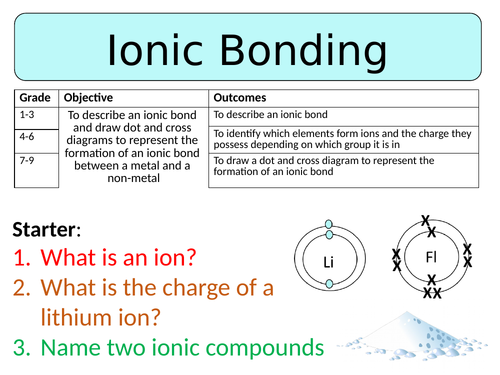
This lesson is designed for the NEW AQA Trilogy Chemistry GCSE, particularly the ‘Structure & Bonding’ SoW.
For more lessons designed to meet specification points for the NEW AQA Trilogy specifications for Biology, Chemistry and Physics please see my shop: https://www.tes.com/teaching-resources/shop/SWiftScience
The lesson starts with a video on ionic bonding, students need to watch the video and answer a set of questions, once complete pupils can self-assess their work. Pupils are then asked to think > pair > share how the group number relates to the charge on the ions formed from that group. Using the PowerPoint presentation you can then demonstrate the link between group number and number of electrons lost/gained by a specific atom, students can use these rules to help work out the charges on ions formed. To assess their knowledge of this, pupils will be asked to copy and complete a table to identify the number of protons, electron, the electronic configuration of an atom and of the ion of that atom, as well as the ion’s charge. Pupils can self or peer assess their work using the answers provided in the PowerPoint presentation.
The next part of the lesson is for pupils to consider the ionic bond formed in calcium chloride, students will first need to draw the electronic configuration of a calcium and chlorine atom and then looking at the structure try and work out how an ionic bond might form between them. Once pupils have had a go you can reveal the answers using the diagrams and descriptions provided in the PowerPoint presentation, for those pupils who were unable to work it out it may be best for them to copy down the diagram in their books.
Pupils will now be asked to draw diagrams to demonstrate the ionic bonds formed between a set of elements - calcium and oxygen, potassium and chlorine, sodium and oxygen, magnesium and chlorine. Once complete they can assess and correct their work using the answers provided in the PowerPoint presentation.
The last activity is an exam-style question which pupils can complete in silence, and at the back of their books if it is a higher ability class. When complete the work can be red-pen assessed using the mark scheme provided.
The plenary activity is for pupils to summarise what they have learnt in the lesson in three sentences, using as many of the key words provided as possible.
All resources are included at the end of the presentation. Thanks for looking, if you have any questions please let me know in the comments section and any feedback would be appreciated :)
Get this resource as part of a bundle and save up to 50%
A bundle is a package of resources grouped together to teach a particular topic, or a series of lessons, in one place.
Something went wrong, please try again later.
Awesome Resource, just one tiny correction. I wanted to contact you some other way to inform you of this. Ionic Bonding - Exam style question _ Magnesium and Sulfur forms magnesium sulfide not magnesium sulfate
Report this resourceto let us know if it violates our terms and conditions.
Our customer service team will review your report and will be in touch.
